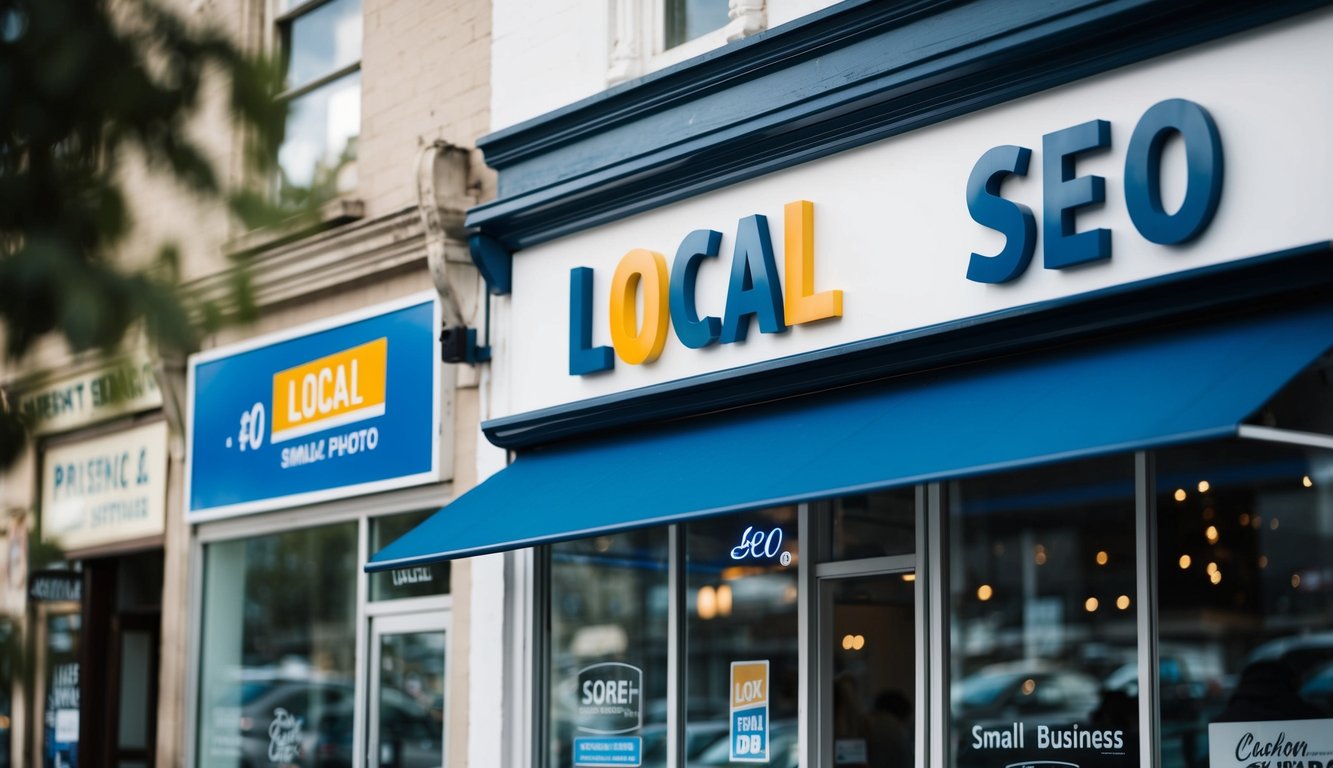What is Search Engine Optimization? A Concise Guide to SEO
What is Search Engine Optimization? It is a crucial aspect of digital marketing that can significantly impact your website’s visibility and success. SEO is the practice of optimizing websites and web pages to improve their visibility in search engine results pages (SERPs) for relevant queries. By implementing effective SEO strategies, you can attract more organic traffic to your site and increase your online presence.

When you optimize your website for search engines, you’re essentially making it easier for search engines like Google to understand and rank your content. This involves various techniques, including improving your website’s technical structure, creating high-quality content, and building authoritative backlinks. By focusing on these elements, you can enhance your website’s chances of appearing higher in search results, ultimately leading to more clicks and potential customers.
Investing time and effort into SEO can yield substantial long-term benefits for your business. As you climb the ranks in search results, you’ll likely experience increased organic traffic, improved brand awareness, and higher conversion rates. Moreover, SEO can help you stay ahead of your competitors and establish your website as a trusted source of information in your industry.
Key Takeaways
- SEO improves your website’s visibility in search engine results pages
- Implementing effective SEO strategies can attract more organic traffic to your site
- Investing in SEO yields long-term benefits for your business’s online presence
The Fundamentals of SEO
Search engine optimization (SEO) is crucial for improving your website’s visibility in search results. It involves several key concepts and practices that work together to boost your online presence.
What is Search Engine Optimization?
SEO is the practice of optimizing websites and content to rank higher in search engine results pages (SERPs). By implementing SEO strategies, you can increase your site’s organic traffic and attract more potential customers.
SEO encompasses various techniques, including:
- Keyword research and optimization
- Content creation and improvement
- Technical website optimizations
- Link building
When done correctly, SEO can provide long-term benefits for your website, helping you achieve better rankings and increased visibility in search results.
Key SEO Concepts
To succeed in SEO, you need to understand and apply several important concepts:
- On-page SEO: This involves optimizing individual web pages to rank higher and earn more relevant traffic. It includes elements like title tags, meta descriptions, and content optimization.
- Off-page SEO: These are actions taken outside of your website to impact your rankings. Link building is a crucial off-page SEO tactic.
- Technical SEO: This focuses on improving your website’s technical aspects to help search engines crawl and index it more effectively.
- User experience: Search engines prioritize websites that provide a positive user experience, including fast load times and mobile-friendliness.
Understanding Search Engines
Search engines like Google and Bing use complex algorithms to determine which websites to display in search results. These algorithms consider numerous factors when ranking web pages.
Key aspects of how search engines work include:
- Crawling: Search engines use bots to discover and collect information from web pages.
- Indexing: The collected information is organized and stored in a massive database.
- Ranking: When a user performs a search, the engine retrieves relevant results from its index and ranks them based on various factors.
By understanding these processes, you can better optimize your website to meet search engine requirements and improve your chances of ranking higher in search results.
Technical SEO
Technical SEO forms the foundation of a website’s search engine optimization efforts. It focuses on improving the technical aspects of your site to enhance its visibility and performance in search engine results.
Site Architecture Essentials
A well-structured site architecture is crucial for both users and search engines. Create a logical hierarchy for your web pages, using clear categories and subcategories. Implement a flat site structure, keeping important pages within three clicks from the homepage.
Use descriptive URLs that include relevant keywords. Implement internal linking to distribute link equity and help search engines understand your site’s structure. Create an XML sitemap to guide search engines through your site’s content.
Optimize your robots.txt file to control which parts of your site search engines can access. This helps prevent crawling of unimportant pages and conserves crawl budget for your most valuable content.
Crawling and Indexing
Ensure search engine crawlers can easily access and understand your website’s content. Use the Google Search Console to monitor your site’s crawl status and identify any issues.
Fix broken links and redirect errors to maintain a healthy link structure. Implement canonical tags to avoid duplicate content issues, especially for e-commerce sites with multiple product variations.
Optimize your page titles, meta descriptions, and header tags (H1, H2, etc.) to provide clear signals about your content’s relevance. Use schema markup to provide additional context to search engines about your content’s meaning.
Boosting Site Performance
Site speed is a critical ranking factor and affects user experience. Optimize your images by compressing them and using appropriate file formats. Minimize CSS and JavaScript files to reduce load times.
Implement browser caching to store static files on users’ devices, speeding up subsequent page loads. Use a content delivery network (CDN) to serve your site from servers closer to users’ geographic locations.
Focus on improving your Core Web Vitals, which include Largest Contentful Paint, First Input Delay, and Cumulative Layout Shift. These metrics measure loading performance, interactivity, and visual stability, respectively.
Ensure your site is mobile-friendly, as Google primarily uses mobile-first indexing. Test your site’s mobile usability and fix any issues to provide a seamless experience across all devices.
On-Page SEO Strategies

On-page SEO involves optimizing individual web pages to rank higher in search results. It focuses on content quality, HTML elements, and overall user experience. Implementing effective on-page strategies can significantly boost your website’s visibility and organic traffic.
Optimizing Content for SEO
Start by conducting keyword research to identify relevant terms for your topic. Incorporate these keywords naturally throughout your content, including in headings, subheadings, and the first paragraph.
Create high-quality, original content that addresses user intent. Aim for comprehensive coverage of your topic, providing valuable information to your readers.
Use descriptive, keyword-rich URLs for your pages. For example:
www.yoursite.com/on-page-seo-strategies
Break up your content with bullet points, numbered lists, and short paragraphs to improve readability. Include relevant images, videos, or infographics to enhance user engagement and understanding.
Meta Tags and Title Tags
Craft compelling title tags that accurately describe your page content and include your target keyword. Keep titles under 60 characters to ensure they display fully in search results.
Write unique meta descriptions for each page, summarizing the content and including a call-to-action. Aim for 150-160 characters to maximize visibility in search snippets.
Optimize your header tags (H1, H2, H3) by including relevant keywords and maintaining a clear hierarchy. Use only one H1 tag per page, typically matching or closely related to your title tag.
Using Structured Data
Implement structured data markup to provide search engines with additional context about your content. This can lead to rich snippets in search results, improving click-through rates.
Use Schema.org vocabulary to markup various content types such as articles, products, or events. Test your structured data using Google’s Rich Results Test tool to ensure proper implementation.
Consider adding FAQ schema to relevant pages, addressing common user questions. This can help your content appear in featured snippets and increase visibility in search results.
Understanding Keywords

Keywords form the foundation of effective SEO strategies. They connect user searches with relevant content and help search engines understand your website’s purpose.
Keyword Research Fundamentals
Keyword research involves identifying terms and phrases your target audience uses when searching for information related to your content. Start by brainstorming topics relevant to your business or website. Use keyword research tools to expand your list and gather data on search volume and competition.
Consider long-tail keywords – longer, more specific phrases that often have lower search volume but higher conversion potential. These can be easier to rank for and attract more targeted traffic.
Analyze your competitors’ keyword strategies to uncover opportunities and gaps in your own approach. Look for keywords they’re ranking for that you might be missing.
Search Intent and Relevance
Understanding search intent is crucial for choosing the right keywords. Search queries can be categorized into four main types: informational, navigational, commercial, and transactional.
Match your content to the user’s intent behind each keyword. For example:
- Informational: “how to optimize website”
- Navigational: “Moz SEO guide”
- Commercial: “best SEO tools”
- Transactional: “buy SEO software”
Ensure your content is relevant to the chosen keywords. Search engines prioritize pages that best satisfy user intent and provide valuable information.
Keyword Optimization
Once you’ve selected your target keywords, optimize your content around them. Place keywords strategically in:
- Page titles
- Meta descriptions
- Headings (H1, H2, H3)
- URL structures
- Image alt text
Avoid keyword stuffing, which can harm your rankings. Instead, focus on natural integration that enhances readability and user experience.
Use variations and synonyms of your main keywords to broaden your content’s reach. This helps you capture related searches and improves your overall SEO performance.
Regularly monitor your keyword performance and adjust your strategy as needed. SEO is an ongoing process, and staying adaptable is key to maintaining and improving your search rankings.
Off-Page SEO and Link Building

Off-page SEO involves tactics to improve your website’s search rankings without changing the site itself. It focuses on building credibility and authority through external signals.
The Role of Backlinks
Backlinks are the cornerstone of off-page SEO. They act as “votes of confidence” from other websites to yours. Quality matters more than quantity when it comes to backlinks.
You should aim to acquire links from reputable, relevant sites in your industry. Natural link building techniques include creating valuable content that others want to reference and share.
Guest posting on authoritative blogs can help you earn quality backlinks. Reach out to influencers and industry experts to build relationships that may lead to link opportunities.
Social Media Influences
While social signals aren’t direct ranking factors, social media activity can indirectly boost your SEO efforts. Sharing your content on social platforms increases visibility and the chances of earning natural backlinks.
Engage with your audience on social media to build brand awareness. This can lead to more branded searches, which is a positive signal to search engines.
Use social media to distribute your content widely and encourage sharing. This amplifies your reach and can attract the attention of potential linkers.
Trust and Authority
Building trust and authority is crucial for off-page SEO success. Search engines aim to deliver results from trustworthy sources to users.
Consistently publishing high-quality, original content helps establish your expertise. Collaborate with industry leaders and participate in relevant online communities to boost your credibility.
Earn mentions and citations from respected websites in your field. These references, even without links, can enhance your site’s perceived authority.
Consider local SEO strategies if you have a physical business location. Claiming and optimizing your Google My Business listing can improve local search visibility.
Content Marketing and Search Engine Optimization

What is search engine optimization? Content marketing and SEO are closely intertwined strategies that work together to improve online visibility and attract quality traffic. When implemented effectively, they can significantly boost your website’s search engine rankings and user engagement.
Creating Valuable Content
High-quality content is essential for successful SEO. You should focus on creating informative, engaging, and unique content that addresses your audience’s needs. This includes blog posts, articles, videos, and infographics that provide real value to your readers.
Use keyword research to identify relevant topics and incorporate them naturally into your content. Aim for comprehensive coverage of subjects, as longer, more detailed content tends to perform better in search rankings.
Remember to optimize your content for readability. Use subheadings, bullet points, and short paragraphs to make it easy for users to scan and digest information quickly.
Content and User Experience
User experience plays a crucial role in SEO. Your content should be easily accessible, well-organized, and mobile-friendly. Pay attention to site speed, as slow-loading pages can negatively impact both user experience and search rankings.
Incorporate internal links to guide users through your site and help search engines understand your content structure. Use descriptive anchor text for these links to provide context and improve navigation.
Consider the visual aspect of your content. Include relevant images, videos, or infographics to break up text and enhance engagement. Ensure all multimedia elements are properly optimized with descriptive alt text and file names.
The Connection with Social Media
What is search engine optimization in social media. While social media signals aren’t direct ranking factors, they can indirectly impact your SEO efforts. Sharing your content on social platforms can increase visibility and drive traffic to your site.
Encourage social sharing by adding share buttons to your content and creating eye-catching social media snippets. Engage with your audience on these platforms to build relationships and foster brand loyalty.
Social media engagement can lead to more backlinks as users discover and share your content. This increased exposure can result in higher-quality traffic and improved search engine rankings over time.
SEO for E-commerce

E-commerce SEO focuses on optimizing online stores to rank higher in search results and drive more targeted traffic. Effective strategies can boost your visibility, increase conversions, and grow revenue.
Product Page Optimization
To optimize product pages, start with thorough keyword research. Include relevant keywords in your product titles, descriptions, and meta tags. Use unique, detailed product descriptions that highlight key features and benefits.
Add high-quality images with descriptive alt text. Implement structured data markup to enhance your product listings in search results. This can include price, availability, and customer ratings.
Ensure your product pages load quickly and are mobile-friendly. A fast, responsive site improves user experience and can positively impact your search rankings.
Customer Reviews and SEO
Customer reviews play a crucial role in e-commerce SEO. They provide fresh, user-generated content that search engines love. Encourage customers to leave reviews by sending follow-up emails after purchases.
Display reviews prominently on your product pages. This builds trust and can increase conversion rates. Search engines may also display star ratings in search results, making your listings more attractive.
Respond to customer reviews, both positive and negative. This shows you value customer feedback and can help address potential concerns of future buyers.
E-commerce Site Architecture
A well-structured site architecture is essential for e-commerce SEO. Organize your products into logical categories and subcategories. This helps search engines understand your site structure and improves crawlability.
Implement a clear, hierarchical URL structure that reflects your site’s organization. For example: yourstore.com/category/subcategory/product-name.
Use internal linking to connect related products and categories. This helps distribute link equity throughout your site and can improve the ranking potential of deeper pages.
Create a comprehensive XML sitemap and submit it to search engines. This ensures all your important pages are discovered and indexed.
Local SEO and Small Business

Local SEO helps small businesses connect with nearby customers searching for products or services in their area. It focuses on optimizing online presence for location-specific queries and improving visibility in local search results.
Optimizing for Local Searches
To optimize for local searches, start by identifying relevant local keywords. Include your city, neighborhood, or region in your website’s content, meta tags, and headings. Create location-specific landing pages for each area you serve.
Encourage customer reviews on your Google Business Profile and other platforms. Positive reviews can boost your local search rankings and credibility.
Ensure your website is mobile-friendly and loads quickly. Many local searches happen on mobile devices, so a responsive design is crucial for attracting and retaining local customers.
Importance of Location
Your business location plays a vital role in local SEO success. Google uses location data to provide relevant search results to users.
Make sure your address is consistent across all online platforms. This consistency helps search engines verify your business information and improves your chances of appearing in local search results.
Consider creating content that highlights local events, news, or attractions related to your business. This can help establish your local authority and relevance.
Local Business Listings
Local business listings are crucial for improving your visibility in local searches. Start by claiming and optimizing your Google Business Profile. Add accurate business information, including:
- Name, address, and phone number (NAP)
- Business hours
- Services or products offered
- High-quality photos
Expand your online presence by creating listings on other popular directories like Yelp, Yellow Pages, and industry-specific platforms. Maintain consistency in your business information across all listings to build trust with search engines and potential customers.
Mobile SEO and Responsiveness

Mobile SEO and responsiveness are crucial for reaching users on smartphones and tablets. They involve optimizing your site for smaller screens and ensuring fast loading speeds.
Impact of Mobile Usability
Mobile usability directly affects your search rankings and user experience. A mobile-friendly website adapts seamlessly to different screen sizes, making it easy for visitors to navigate and interact with your content.
Google’s Mobile-Friendly Test helps you assess your site’s performance on mobile devices. It checks for text size, button spacing, and viewport configuration.
Core Web Vitals play a significant role in mobile SEO. These metrics measure loading speed, interactivity, and visual stability. Improving these factors can boost your mobile rankings and user satisfaction.
Page speed is critical on mobile. Users expect quick loading times, especially on-the-go. Optimize images, minify code, and leverage browser caching to enhance your mobile site speed.
Mobile-First Indexing
Google now primarily uses the mobile version of your site for indexing and ranking. This approach reflects the majority of users accessing the web via mobile devices.
To succeed with mobile-first indexing, ensure your mobile site contains the same high-quality content as your desktop version. Avoid hiding content behind tabs or accordions on mobile.
Implement responsive design to serve the same HTML code on any device while using CSS to alter the rendering on different screen sizes. This approach is Google’s recommended configuration for mobile-first indexing.
Check that Googlebot can access and render your mobile content and resources. Use the URL Inspection tool in Google Search Console to verify how Google sees your mobile pages.
Measuring and Tracking SEO Success
Effective SEO requires ongoing measurement and analysis. By tracking key metrics, you can gauge your progress and refine your strategies for optimal results.
Analytics and SEO
SEO success hinges on your ability to analyze data. Start by setting up Google Analytics on your website. This powerful tool provides insights into your organic traffic, user behavior, and more.
Focus on metrics like organic sessions, which show how many visitors arrive from search engines. Pay attention to landing pages receiving the most organic traffic. This helps you identify which content performs well in search results.
Track your keyword rankings to see how your pages fare in SERPs. Use tools like SEMrush or Ahrefs to monitor position changes over time. Remember, rankings can fluctuate, so look for overall trends rather than daily shifts.
Analyze your click-through rates (CTR) from search results. A low CTR may indicate that your meta titles and descriptions need improvement.
Conversion Tracking
Conversion tracking is crucial for measuring SEO’s impact on your bottom line. Set up goal tracking in Google Analytics to monitor specific actions users take on your site.
Common conversion goals include:
- Form submissions
- Product purchases
- Email newsletter sign-ups
- PDF downloads
Calculate your conversion rate by dividing the number of conversions by total organic visitors. This metric helps you understand how well your SEO efforts translate into tangible results.
Use UTM parameters in your URLs to track which specific organic keywords or pages drive the most conversions. This information guides your content strategy and keyword targeting.
Audience Engagement Metrics
Engagement metrics provide insights into how users interact with your content after arriving from search results. These indicators help you assess content quality and relevance.
Key engagement metrics include:
- Time on page
- Pages per session
- Scroll depth
A high time on page suggests users find your content valuable. Multiple pages per session indicate users are exploring your site further. Scroll depth shows how much of your content users actually consume.
Monitor your bounce rate, but interpret it cautiously. A high bounce rate isn’t always negative, especially for pages that quickly answer user queries.
Use heatmapping tools to visualize user behavior on your pages. This helps identify which elements capture attention and where users might be struggling.
Frequently Asked Questions
SEO encompasses various techniques and strategies that impact digital marketing, content creation, and business success. Understanding key aspects of SEO can help you improve your website’s visibility and drive organic traffic.
How does SEO impact digital marketing strategies?
SEO plays a crucial role in digital marketing by improving a website’s visibility in search engine results pages. It helps attract targeted organic traffic to your site, enhancing brand awareness and credibility.
By optimizing your content for relevant keywords, you can reach your intended audience more effectively. This alignment between user intent and your offerings can lead to higher conversion rates and improved ROI for your marketing efforts.
What are the essential steps for effective SEO?
Effective SEO starts with thorough keyword research to identify terms your target audience is searching for. Conduct a comprehensive site audit to assess your website’s current performance and identify areas for improvement.
Create high-quality, relevant content that addresses user needs and incorporates target keywords naturally. Optimize your website’s technical elements, including page speed, mobile responsiveness, and URL structure.
Build high-quality backlinks from reputable sources to improve your site’s authority. Regularly monitor your SEO performance using analytics tools and adjust your strategy as needed.
What are the different types of SEO techniques?
SEO techniques can be broadly categorized into on-page, off-page, and technical SEO. On-page SEO focuses on optimizing individual web pages, including content, meta tags, and internal linking.
Off-page SEO involves activities outside your website, such as link building and social media marketing. Technical SEO addresses website structure, speed, and crawlability to ensure search engines can easily access and index your content.
How can businesses measure the success of their SEO efforts?
Businesses can track various metrics to gauge SEO success. Monitor organic traffic growth, keyword rankings, and click-through rates using tools like Google Analytics and Google Search Console.
Assess changes in bounce rate and time on page to evaluate user engagement. Track conversion rates and ROI to measure the impact of SEO on your business goals.
Consider using specialized SEO tools like Ahrefs or Semrush for more in-depth analysis and competitor benchmarking.
How does SEO apply to content creation and marketing?
SEO and content marketing are closely intertwined. Create valuable, informative content that addresses your audience’s needs and incorporates relevant keywords naturally.
Optimize your content structure with descriptive headings, meta descriptions, and alt text for images. Ensure your content is easily shareable and encourage quality backlinks to improve its visibility and authority.
Regularly update and refresh your content to maintain relevance and improve search rankings over time.
What are some common SEO best practices for beginners?
Start by conducting keyword research to understand what your target audience is searching for. Optimize your website’s title tags, meta descriptions, and header tags with relevant keywords.
Create high-quality, original content that provides value to your readers. Ensure your website is mobile-friendly and loads quickly across all devices.
Build a logical site structure with clear navigation and internal linking. Focus on earning quality backlinks from reputable sources in your industry.